※剣歯猫 マカイロドゥス / アンフィマカイロドゥス分類の変遷について先に記事を上げたばかりで心苦しいのですが、ほぼ完全なgiganteus種頭骨(ブルガリアの某博物館所蔵。新発見されたものではなく、これまで諸事情により記載の機会を逸していた頭骨です)の形態分析に基づき、既知の他種との比較分析を経て、両属分類の是非を問い直す、新しい研究が発表されました(Geraads et al., 2020)。恐らく、前回の記事内容には加筆修正が必要になることを、あらかじめ了承ください。以下は私の英語サイトの方で既に投稿した英文での記事になりますが、新知見とは矛盾しない形で、マカイロドゥス分類の変遷を再度まとめ直しました。のちに日本語にして投稿しなおします。不便かとは思いますが、分かる人はチェックしてみてください。あわただしくて申し訳ない💧
Confusing indeed! It seems that controversial Machairodus / Amphimachairodus classification issue still hasn't reached a solid consensus, yet.
Originally, the mainstream idea was to differentiate between Machairodus specimens of the Vallesian period (mid-Miocene) and those of the Turolian period (late Miocene) at the species level.
Since the discovery of the impressive aphanistus sample from the Spanish fossil site Batallones-1, some researchers(Morales(1984), Anton et al.(2004)) began to confirm generic level differences between the Vallesian aphanistus and those from the late Miocene-early Pliocene. The latter was described by them as having significantly more derived features than M. aphanistus and was then assigned to the new genus Amphimachairodus.
Subsequent machairodont phylogenetic studies(Werdelin et al.(2010), Christiansen(2013)) with advanced morphometric technologies further support this new taxonomy. Christiansen(2013) placed the Vallesian Machairodus aphanistus, along with Nimravides and Promegantereon within taxonomically 'unresolved basal machairodonts' which didn't yet exhibit a suite of advanced machairodont characters.
Whereas monophyly of advanced scimitar toothed cats 'homotherines' which includes the late Miocene Amphimachairodus and the two Pleistocene genera(Homotherium and Xenosmilus) was maintained, due to their cranio-dental similarities. Thus, in this classification, an ancestor-descendant relationship between Machairodus and Amphimachairodus cannot be supported.
A new study by Geraards et al.(2020) on the other hand, who compared the complete skull of giganteus from the late Miocene Hadjidimovo, Bulgaria, with the skulls of other 'Machairodus', comes to the conclusion that clear morphological differences between aphanistus and giganteus are limited(such as the elevation of the cerebral skull above the level of the tooth-row and deference in the size of P3), and the rest is not as distinct as previously claimed.
These observations do not exclude an evolutionary relationship between giganteus and aphanistus, and assigning the late Miocene species to different genera is meaningless, according to Geraads et al.(2020).
Does this mean that we now return to 'the original' taxonomy in which all known Machairodus species are classified under the same genus rank? We might also need to hear counterarguments if any, from pro-Amphimachairodus researchers.
At any rate, Geraads et al.(2020) admits that the differences between the early and late stages exceed what's commonly accepted for intra-specific variation : the late Miocene forms especially the latest ones were more derived and larger than aphanistus.
There are also 'intermediate forms' known to have existed, indicating that the transition may have been gradual and mosaic.
Historically, several specimens of these late stages have been given own species rank different from giganteus. Machairodus(Amphimachairodus)h

((Amphi)Machairodus kabir from the late Miocene central Africa(Chad))

(left: giant (Amphi)Machairodus horribilis from the late Miocene northwestern China)
イラスト by ⓒthe Saber Panther (All rights reserved)
In the current Wikipedia article(英語版と日本語版), Machairodus, along with other mid Miocene forms Hemimachairodus and Miomachairodus, is included in another phenotypic clade 'Machairodontini', independently from Homotherini, but this distinction doesn't seem to be correct, since Machairodontini is generally considered just synonymous with Homotherini.
Assuming Geraads et al.(2020) is correct, and both aphanistus and subsequent species are being classified under Machairodus, will the genus be considered a part of homotherines?
If the traditional assertion that aphanistus was more apomorphic than later specimens would stand, would it be still appropriate to incorporate Machairodus along with other post late Miocene taxa such as Megantereon, Homotherium, Xenosmilus and Smilodon into 'Eumachairodontia'?
What do you think?
Lastly, as to the size of late Miocene Machairodus(or Amphimachairodus?) as we discussed before, there seems to have been more other 400+ mm class giant skulls that are not being mentioned in academic literature, circulating among serious private fossil collectors. I guess it's worth looking forward to genuine reports of another record-breaking specimens in the future.
イラストと記事: ⓒthe Saber Panther (All rights reserved)
当記事内容の無断転載、転用、利用を禁じます










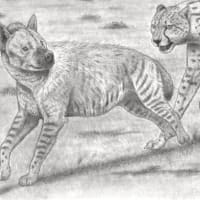


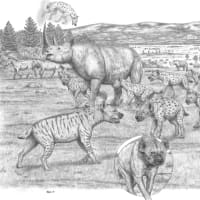
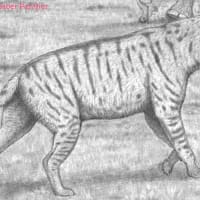
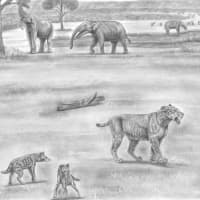
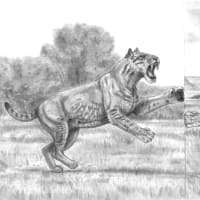

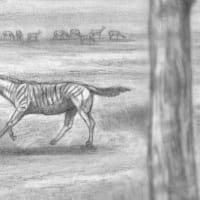
※コメント投稿者のブログIDはブログ作成者のみに通知されます